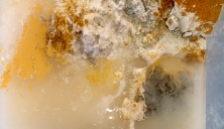My thoughts have been directed to change, counting time and mapping data, the aura of place and sacred sites, and the lure of the apocalypse.

As Utopia is no place so Uchronia is no time.
Helga Schmid gave a very interesting presentation on Uchronia at the Material Environments Symposium, University of Greenwich. First used by Charles Renouvier in the title of his 1876 novel which translates as Uchronia (Utopia in History), an Apocryphal Sketch of the Development of European Civilization Not as It Was But as It Might Have Been.
Uchronia suggests an alternative history, a what if scenario. Helga is interested in the possibility of changing the time constraints society forces upon us to allow us a more natural experience of time in tune with circadian rhythms and our natural sleep patterns. Her research looks at the transition from agricultural to urban society, the temporal fragmentation from punctuality to flexibility and the ongoing pressures of speed and acceleration which conflict with the human biological clock. She conducts experiments with groups of people removed from clocks and natural light to explore biological and societal constraints with a view to advocating a new lived experience of time which does not conform to the temporal structure of contemporary technology driven life.
Another speaker at the symposium, Laura Kurgan uses new technologies to chronicle social change with a view to influencing political ideologies. She has written on the subject of mapping data in Close Up at a Distance.

Satellite data images are built from pixels radioed from outer space. These statistics often record situations of intense conflict and can express fundamental transformations in our ways of seeing and of experiencing space. This data was intended for military and governmental uses but Laura Kurgan repurposed it to open up new spaces and present new views. Technology has brought about a revolutionary shift in our ability to navigate, inhabit, and define the spatial realm. The traces of interactions, both physical and virtual, charted by the maps in Close Up at a Distance define this shift.
Laura Kurgan presents two of her projects which map the movement of people in this link: Human Geographies

Native Land looks at economical migration and money transfers, migration due to natural disasters exacerbated by climate change, loss of forests and loss of native language. Through a series of animated maps and graphs she shows major social change happening on a global scale in an easy to grasp visual format.
What we’ve traditionally called “the universe” — the aftermath of “our” big bang — may be just one island, just one patch of space, in a perhaps-infinite archipelago. There may have been an infinity of big bangs, not just one. Each constituent of this “multiverse” cooled down differently, ending up governed by different laws. – Lord Martin Rees
Current theories in physics that debate the possibility of us living in a multiverse challenge our perceptions of space and time.

This subject was tackled in Constellations a play by Nick Payne. It was superb theatre acted impeccably by Louise Brealey and Joe Armstrong and powerfully directed by Michael Longhurst.

Constellations by Nick Payne
Constellations takes one relationship and looks at alternative scenarios and the possible outcomes of infinite possibilities. What if we live in a multiverse and every decision we make is somewhere else happening just slightly different? The twists and turns and subtleties that these actors brought to life in funny and heart rending moments was astonishing in itself and then the ideas that this play throws up about the big questions of our place in the universe and our relationship to death added depth and resonance to a play that stays in your heart. It helped to analyse the concept of a multiverse in very human terms.
We are fascinated by the disaster. The allure of the sublime always contains some element of death.
Shown by curators Coates and Scarry in Complicit Kate MccGwire’s sleek feathered sculptures and Juliette Losq’s muted watercolour landscapes take you to the edge where beauty slides into a sort of dissonance.

Kate MccGwire Taunt
MccGwire’s amorphous shapes that gleam and curl in upon themselves sit well with the lost spaces Losq creates in both 2D and 3D where she physically tears through the paper landscape drawing you further in to a world falling apart around you.

Juliette Losq Covert
The beauty of destruction on an epic scale was showing at Thomas Dane in a screening of Bruce Conner’s thirty-seven-minute film CROSSROADS produced in 1976 from archival footage of the first nuclear tests conducted in 1946 at Bikini Atoll.

Bruce Conner Crossroads
As terrifying as it is beautiful, CROSSROADS plays witness to the detonation of a nuclear weapon as powerful as the atomic bomb dropped on Nagasaki, ninety feet below the surface of the ocean, under a fleet of decommissioned naval ships as test subjects for the bomb’s destructive powers.
Sixty-four aircraft with 328 cameras (some of which were radio-controlled drones) circled the detonation site using high speed film and equipment that would take a million pictures in the first few seconds of the explosion. This event was to be the most comprehensively photographed moment in history.
Conner was able to draw upon this extensive footage allowing the viewer to experience the detonation repeatedly in a constant succession of waves, overwhelming in its beauty and tragedy creating an unbearable ecstasy.
Bikini Atoll caught in the crossfire symbolises the dawn of the nuclear age, despite its paradoxical image of an earthly paradise.

Bikini children leaving the island 1946
The terrible legacy of the nuclear tests lives on through the forced displacement of the indigenous people of these islands whose homes and health were sacrificed.

Peter Kennard
The politics of Peter Kennard are blatantly siphoned into his art with no apologies.
I visited his major retrospective at the Imperial War Museum which I found moving in its directness.

Peter Kennard
I was interested in Matt Gee’s exhibition Nutri-Artifice at Gallery 286 for his use of crystals and human intervention in landscape. He shows us an unreal beauty. Chemical colours and textures mingle in an unclear divide between the artificial and the organic.

Matt Gee Mountain Bend
Marc Quinn was also exploring desire and the artificial in The Toxic Sublime at White Cube, Bermondsey. In his Toxic Sublime series the use of sugary colours echoes the formulaic image of the sun rising over the ocean that he takes as his starting point and then the sickly sweet is attacked, frottaged with municipal street architecture, blasted to aluminium before finally being bent and geometrically distorted.

Marc Quinn The Toxic Sublime
If it was the vulgar Quinn wanted to expose with this process then it works and the repetition in the gallery adds to this toxic overload. The sculptures in the same show vary dramatically from a similar overdone crudeness to the sublime.

Marc Quinn at White Cube
Frozen Wave, in highly polished stainless steel, has all the magnificence of a weight of water about to crash. It embodies the frisson of disaster that holds you in awe of its power and beauty. Vast and primordial Frozen Wave (The Conservation of Energy) makes connections between nature and humanity that resonate deep within us.

Marc Quinn Frozen Wave (The conservation of energy)

I was pleased to be invited to take part in the Rising Stars exhibition at Coombe Gallery, Dartmouth, Devon.

Coombe Gallery
For this show I mounted some of the screenprints I had made on paper from the everydaymatters series.

Susan Eyre everydaymatters (tropical SE16)
I used laser cut mdf circles and painted the backs with fluorescent paint so they radiate a glow on the wall behind.

One step to my independence has been the purchase of a power saw to cut mitre joints for sub-frames to hang work. Not very exciting but I was able to make my own subframes for this work so they can sit a little out from the wall.

Susan Eyre everydaymatters (tropicalia SW3)
I have been pleased that I was able to transfer the screenprints I had made on fabric onto mdf too. I have been able to collage these with new sublimation prints and am quite pleased with the outcome.

A lot of my time since leaving the RCA seems to have been taken up by admin, submitting proposals, writing statements, framing up or mounting work, delivering and picking up.

Susan Eyre everydaymatters (palm SW4)
I used the trip delivering work to Dartmouth to stop off and look at some Neolithic landscape as part of my research looking at ancient rituals and then considering their modern equivalent.

Dating from 2300 BC, Woodhenge is thought to have marked a particular stage in the evolution of human religious belief and community organisation. Originally believed to be the remains of a large burial mound the concrete markers that stand there today replace the six concentric rings of timber posts which are believed to have once supported a ring-shaped building. The small grave in the centre believed to be of a child is still paid homage to with candles and flowers today.

On the day I visited there were TV cameras and helicopters overhead as news was broadcast that archeologists have discovered evidence of the hidden remains of a massive Neolithic stone monument, thought to have been hauled into position more than 4,500 years ago completely rewriting the history of Stonehenge and the surrounding area.

While I was in Devon I was also able to visit Widecombe Fair famed for the ditty from which this verse is taken…
When the wind whistles cold on the moor of the night.
All along, down along, out along lea.
Tom Pearce’s old mare doth appear ghastly white,
With Bill Brewer, Jan Stewer, Peter Gurney,
Peter Davy, Dan’l Whiddon, Harry Hawke,
Old Uncle Tom Cobley and all,
Old Uncle Tom Cobley and all.

Widecombe Fair
I was interested to see if I could identify any ancient rituals being passed on and adapted
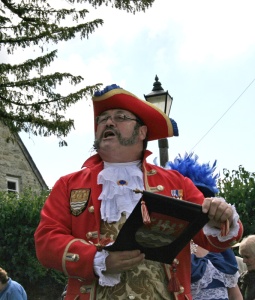
Widecombe Fair Town Cryer competition

Widecombe Fair Prize Vegetables


Viking re-enactment with mystic raven

Widecombe Fair Morris Dancers
In another excursion west I was pleased to have my sculptures everydaymatters selected for the Wells Art Contemporary by judges Richard Wentworth, Mariele Neudecker and Donald Smith.

Susan Eyre everydaymatters

Susan Eyre everydaymatters
As space was tight in the Wells and Mendip Museum where the exhibition takes place it was only possible to show three of the seven but I did have a great backdrop in Wells Cathedral.

Susan Eyre everydaymatters
While in Wells I took the opportunity to visit their impressive Cathedral. Set upon the source of ancient springs (or wells) there has been a sacred site here since the first human settlements.
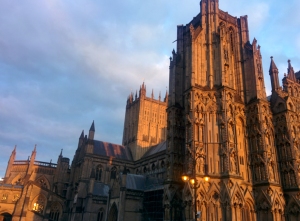
This most ancient Cathedral is also famous for its astronomical clock and it was a real treat to see it theatrically strike the hour.
The clock is inspiring not only for its immense age but the intricacies of its design and mechanisms. The ornamental dial depicts the pre Copernican geocentric view of the universe, with the sun and moon revolving around earth at the centre.

Above the clock sitting in the corner is a figure, known as Jack Blandifers, who has been counting time for over 600 years. Every 15 minutes he hits a bell with a hammer and two bells with his heels while above the clock a troupe of jousting knights hurtle around a podium.

Carsten Höller intends for his work to bring about ‘moments of not knowing.’ For his exhibition at the Hayward Gallery Decision you enter through Decision Corridors a dark tunnel which twists and turns and divides. It is a hesitant journey made by feeling along the walls and punctuated by screaming teenagers careering though at speed.

Carsten Höller Flying Mushrooms
I liked the Flying Mushrooms mechanisms of interconnecting cogs and rotating orbs which seemed to represent an alternative solar system. There was the opportunity to push a bar which in turn moved the cogs.

Haywood Gallery
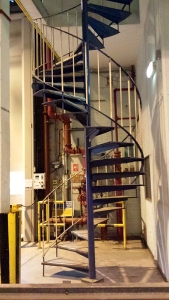
BBC Drama Block
Most of the exhibits in this show were participative in some way and the decisions were much about whether to push the bar, take the pill, or ride the slide but some did interfere with perception in an uncomfortable squeaky chalkboard sort of way.

Carsten Höller The Forests
I found I couldn’t cope with The Forests a dual screen video shown on a headset that splits your vision in two as one eye takes a route in the forest one way and the other eye another. This made me squirm as I felt my brain trying to cope and reconnect to one single image made from both eyes.

The mysterious title of Ben Rivers cinematic installation The Two Eyes Are Not Brothers originates from a whispered warning overheard in a Tangiers café by Paul Bowles.

Composer and novelist Bowles and his wife Jane settled in Morocco in the forties. In turn inspired by this landscape Ben Rivers films weave in and out of fiction and reality layering the violent narrative from Bowles short story A Distant Episode of a European abducted by bandits though re-enactment by non actors using the abandoned film sets that litter the Atlas Mountains. By chance while in Tangier, Rivers meets and subsequently films Mohammed Mrabet now 79 who once inspired the Bowles couple with his stories of local folklore.

Ben Rivers The Two Eyes Are Not Brothers
Another serendipitous opportunity for Rivers to add yet another layer was meeting artist Shezad Dawood on location independently filming for his own work.

This palimpsest of stories, real and fictional, is then appositely presented in the former BBC Drama Block at White City currently due for demolition.

Ben Rivers installation at BBC White City
Led into a world that has moved on there is the chance to explore the vast BBC studios before they are erased.


In an interview in the Paris Review 1981 Paul Bowles responds to the question of violence in his work
“Yes, I suppose the violence served a therapeutic purpose. It’s unsettling to think that at any moment life can flare up into senseless violence. But it can and does, and people need to be ready for it. What you make for others is first of all what you make for yourself. If I’m persuaded that our life is predicated upon violence, that the entire structure of what we call civilization, the scaffolding that we’ve built up over the millennia, can collapse at any moment, then whatever I write is going to be affected by that assumption. The process of life presupposes violence, in the plant world the same as the animal world. But among the animals only man can conceptualize violence. Only man can enjoy the idea of destruction.”

Up Projects with The Floating Cinema presented a series of events for Extra-Terrestrial London a highlight of which was the screening of Shezad Dawood’s Piercing Brightness.

Before the screening Shezad gave an informal talk aboard a canal boat to explain how the film had come about and how he found Preston to be the perfect setting for a film about what it means to be alien.

Shezad Dawood Piercing Brightness
There is a loose narrative to the film. Two alien youths land in a spaceship outside Preston. Their mission is to re-establish contact with the ‘Glorious 100’ sent to earth millennia ago in human form to study and observe the development of another race.

Shezad Dawood Piercing Brightness
After making contact with one of the 100, they discover that many of their kind have forgotten their original purpose and have slowly become integrated into their adopted home and no longer want to return to their home planet.

Chudamani Clowes White City
Migration and integration both current and historical were addressed by Chudamani Clowes in her solo show at the Griffin Gallery White City.

White City is the area local to the Griffin Gallery and gained its name from the white painted buildings of the Franco-British exhibition of 1908. At the time it was the largest exhibition of its kind in Britain and presented a number of model villages reconstructed to celebrate imperial achievements. This included Ballymaclinton, a ‘genuine’ Irish village. At the French Senegalese village, complete with imported ‘natives’, visitors could watch traditional dance performances. And at the Indian Arena, Bollywood-style spectaculars were performed.

Chudamani Clowes White City
Chud, moved by news of the current migrant crisis uses the analogy of the jellyfish as migrant without borders caught in the ebb and flow of life to offer us the chance to rethink what it means to be other.

Chudamani Clowes Jellyfish Dance
For the opening event the audience took part in a jellyfish procession from Griffin Gallery to White City tube station via the modern monolith of Westfields shopping centre and the current redevelopment of the BBC studios.

As colourful and spirited as her work Chud led the procession majestically trailing silver tentacles as we followed wearing Chud’s trademark bonnets creating the sparkling seas from undulating survival blankets in unison.

In an Interview. about her work she talks of how she saw desperate migrants on the news having nothing yet looking almost regal wrapped in gold rescue blankets.
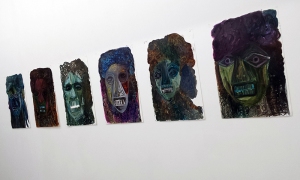
Chudamani Clowes White City
Her work aims to highlight perception and distortion and so she used these blankets to make a shelter in which see yourself reflected and distorted, you become other.
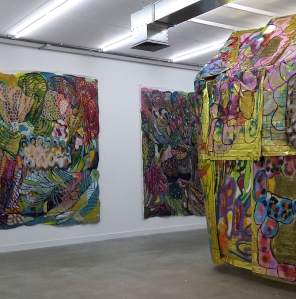
Chudamani Clowes White City
Chud talks about how important it is to tell our stories and keep our memories alive. To look at local history and appreciate that the oasis’ of culture we enjoy today are the hubs where migrants settled in the past.
Whenever you go down the roads in Britain, you travel not in three dimensions but in four. The fourth dimension is the past. And as we move to and fro in this fourth dimension, we see not only landscape but the economic, political and social forces at work behind the landscape, shaping it, forever changing it…
Travis Elborough and Bob Stanley

My second viewing of the film How We Used to Live was further enhanced by the live accompaniment of Saint Etienne playing the beautifully beguiling soundtrack.

Splicing old BFI colour film footage of a lost London we are transported back to a pre digital world to witness the change from capital of industry to financial hub.

I am interested in the aura of place and how this is defined. I joined The London Occult Walk led by practising witch Delianne Forget who promised to point out the haunts and meeting places of magicians, witches and secret societies. Following a route from Embankment to Covent Garden we were encouraged to speculate on what might have occurred at certain sites along the way. We were asked to imagine the grand houses that once lined the embankment where nobility of the 16th and 17th centuries lived and the beliefs they held regarding the supernatural.
We began the walk on Villiers Road. I have had lots to research from this walk as many historical names and events were mentioned along the way.
There were stories of George Villiers (1592-1628) who became the favourite of James I and then Charles I and who was a big influence on the royals but not popular with the government due to some of the other company he kept such as John Lamb who was accused of performing black magic. Both George Villiers who became The Duke of Buckingham and John Lamb were murdered, the first ambushed by a peeved army officer and the second stoned to death by a mob angry that due to his noble friends influence he had escaped justice for the violent rape of a young girl.

We stopped at the grand Royal Society of Artists building. Founded in a Covent Garden coffee house in 1755 the RSA moved in 1774 to this purpose built home set on the ancient site where the episcopal palace of Durham House once stood. Durham House dated from 1345 and was home to Sir Walter Raleigh while he was a favourite of Elizabeth I.
Around 1592 Sir Walter Raleigh led the esoteric group The School of Atheism later nicknamed The School of Night where alchemists, astronomers, astrologers, mathematicians and poets met and mingled their philosophies. This sort of debate was disapproved of by the church who wished to stamp out any interest in the sciences and preserve a geocentric view of the world.

This trace from the past led us from Sir Walter Raleigh and Elizabeth I to the famed astrologer and occult philosopher John Dee who was the Queen’s trusted advisor and interpreter of the heavenly auspices. He would be summoned to Windsor for his opinion at the sudden appearance of a comet. There was no delineation between science and magic at the time. John Dee believed contact could be made with the spirit world via his crystal ball and obsidian scrying mirror.

John Dee’s magical items held at The British Museum
He was keen to work alongside other mediums who could contact the dead and thought he had found the ideal partner in Edward Kelly. There is a tale of the pair visiting Preston to raise a body dug up in St. Leonards graveyard from the dead with incantations. Relations with Kelly didn’t go so well after he forced Dee into a wife sharing co-op and the once famed alchemist pair split. Kelly ended up falling to his death from a window in an attempt to escape prison and Dee returned to his home at Mortlake out of favour now the Queen was dead, never quite having made his fortune and dying penniless in 1608.

Stopping to look at the 1512 building of Queens Chapel of the Savoy, a tiny church owned by the crown we were told this was the ideal place for an Elizabethan grave robber’s work. What went on and who visited where was much speculated upon and the stories encompassed the past and spread to other figures who are remembered in history for their occultist interests.
Simon Forman was another Elizabethan astrologer who gained fame and notoriety studying the occult arts and practising as a physician until he was banned for not having a license. Despite his creepy and lecherous reputation he was able to get a license from Cambridge university and continue his practise and many of his fascinating case studies are held at the Bodlein Library on Oxford. William Lilly followed in this line of astrology publishing the Christian Astrology in 1647 and even gaining the approval of Oliver Cromwell.

We walked along the Thames to the incongruously sited ancient Egyptian obelisk known as Cleopatra’s Needle.

Here early on a December morning in 1937 as the sun entered Capricorn Aleister Crowley gathered a small crowd representative of each race of mankind and gave each one a copy of his book The Equinox of the Gods. He gave a short speech including his mantra – Do what thou wilt shall be the whole of the law. The book contains an image of the Stele of Revealing held in the Egyptian Museum in Cairo whose significance for Crowley is the depiction of the three chief deities of Thelema.

The origins of the Lyceum Theatre date to 1765 and we stopped to gaze up at a window where Bram Stoker worked as assistant to actor manager Henry Irving at the end of the 1800’s. Dracula was published in 1897. Stoker had an interest in the study of the occult and knew members of the Hermetic Order of the Golden Dawn but there is some dispute as to whether he was a member himself.
Our walk ended in Covent Garden where the original Hell Fire Club was founded by the Duke of Wharton to engage in the popular new pastimes of satire and blasphemy. These clubs were banned in 1721 by George I in a Bill “against ‘horrid impieties”. The most notorious Hell Fire Club set up by Sir Francis Dashwood in 1746 was known at the time as The Order of the Friars of St. Francis of Wycombe. I am reading a history of this club written by Donald McCormick published in 1958 which seems to seek to defend the ‘amorous knights of Wycombe’ as mere sensualists perfectly able to hold respected public office despite their recourse to excessive drinking and ‘wenching’. The sexist and homophobic 1950’s views in this book are just as repugnant as the 1750’s behaviour they defend.
Rich and powerful these men created their own playground and their own rules. The striking golden globe on top of the tower of St. Lawrence’s Church built by Dashwood in 1761 can comfortably seat 4 men and was according to John Wilkes ‘the best Globe Tavern I was ever in.”

St. Lawrence’s Church West Wycombe
Recently passing West Wycombe I stopped off to have a look at the Church.

St. Lawrence’s Church West Wycombe
The Dashwood family mausoleum also on the hill overlooking West Wycombe Park is another flamboyant statement.

Dashwood Mausoleum
A visit to the caves where the brotherhood met will have to wait for another day.
Medmenham Abbey was the headquarters for the Knights of Saint Francis of Wycombe before the caves which became their home were dug out and Dashwood based its refurbishment to his purposes on the Abbey of Thélème inspired by his love of the works of Rabelais and embracing the Thélème motto “FAY CE QUE VOUDRAS” (Do as you please)

Medmenham Abbey
I was interested to note that the Abbey of Thélème has no clocks as Gargantua believed ” the greatest loss of time that I know is to count the hours.”
Going through my old sketchbooks I came across a cutting from the Sunday Times Culture Section dated 22/10/2006 written by Bryan Appleyard who quotes royal astronomer Martin Rees as predicting that we have no better than a 50/50 chance of surviving the 21st century.

It has always been the case that every culture and age sees the End of the World as imminent as though it were hard wired into our species to live in anticipation of destruction. The article Headlong into the Flames is actually a scathing book review of James Martin’s The Meaning of the 21st Century. Appleyard’s own analysis is that there is absolutely no prospect of people ever overcoming enough of their differences even to start to save the planet.

Hearing Lord Martin Rees recently speak at Second Home his analysis of our odds to survive might not have changed but if we do survive he thinks “Evolution will not follow the Darwinian timeline, but instead a new, technological trajectory…..Those who witness the explosion of the sun in four billion years time will be as different to us now as we are to insects”
























































